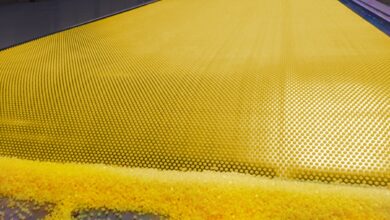New Light-Driven Catalysts Facilitate Manufacturing Processes

Baspar/Iranpolymer Chemical reactions powered by light are extremely helpful to chemists who are developing new methods to make pharmaceuticals and other beneficial compounds. Exploiting this light energy necessitates photoredox catalysts, which can capture light and convey the energy to a chemical reaction. MIT chemists have recently developed a new kind of photoredox catalyst that could make it easier to integrate light-powered reactions into manufacturing methods. In contrast to most currently available photoredox catalysts, the new group of materials is insoluble, so they can be used repeatedly. These catalysts can be employed to coat tubing and carry out chemical alterations on reactants as they travel via the tube.The new catalysts, which can be altered to carry out many diverse types of reactions, can also be integrated into other materials such as particles or textiles.Timothy Swager, the John D. MacArthur Professor of Chemistry at MIT, is the senior author of the study, which has been recently published in the journal Nature Communications. Sheng Guo, an MIT research scientist, and Shao-Xiong Lennon Luo, an MIT graduate student, are also authors of the studyPhotoredox catalysts function by absorbing photons and then utilizing that light energy to drive a chemical reaction, similar to the way chlorophyll in plant cells absorbs energy from the sun and utilizes it to make sugar molecules.Chemists have created two core groups of photoredox catalysts, which are called heterogenous and homogenous catalysts. Homogenous catalysts typically comprise organic dyes or light-absorbing metal complexes. These catalysts can be easily modified to carry out a particular reaction, but the problem is that they dissolve in the solution where the reaction occurs. This means that they cannot be simply extracted and used again.On the other hand, heterogenous catalysts are solid minerals or crystalline materials that create 3D structures or sheets. These materials do not dissolve, therefore they can be used many times. However, these catalysts are tougher to modify to attain a preferred reaction.To integrate the advantages of both of these kinds of catalysts, the scientists planned to insert the dyes that constitute homogenous catalysts into a solid polymer. For this application, the scientists utilized a plastic-like polymer with minute pores that they had earlier created for carrying out gas separations.In this research, the scientists showed that they could integrate nearly 12 diverse homogenous catalysts into their new hybrid material, but they are certain it could work with several more.The scientists learned that adding the catalysts into polymers also enabled them to become more effective. One explanation is that reactant molecules can be contained in the polymer’s pores, ready to react. Furthermore, light energy can effortlessly flow along the polymer to locate the waiting reactants.The scientists also demonstrated that they could tweak the physical features of the polymer backbone, including its porosity and thickness, according to the application they wanted to employ the catalyst for.As one example, they demonstrated that they could produce fluorinated polymers that would adhere to fluorinated tubing, which is frequently used for continuous flow manufacturing. During this kind of manufacturing, chemical reactants pass via a series of tubes while new constituents are incorporated, or other steps such as separation or purification are carried out.At present, it is challenging to add photoredox reactions into continuous flow processes because the catalysts rapidly deplete, so they have to be constantly incorporated into the solution.Adding the new MIT-designed catalysts into the tubing used for this type of manufacturing could enable photoredox reactions to be carried out during continuous flow. The tubing is clear, letting light from an LED pass through and reach the catalysts and stimulate them.The catalysts could also be employed to coat magnetic beads, rendering them easier to extract out of a solution once the reaction is completed, or to coat reaction textiles or vials. The scientists are currently attempting to integrate a wider range of catalysts into their polymers and engineering the polymers so that they can be employed in various potential applications.The National Science Foundation and the KAUST Sensor Initiative funded the study.
azom






